I have plotted the Lorenz attractor on a 3d graph. I am wanting to see how the size of the growth rates of the bred vectors affect the lorenz attractor, by plotting different coloured points representing different sizes of growth rates onto the lorenz graph.
This is the code I have at the moment:
fig = plt.figure(figsize=(8, 8))
ax = fig.add_subplot(111, projection = '3d')
plot lorenz
ax.plot(x1, y1, z1)
add growth rate markers
ax = fig.add_subplot
for k in range(100):
if (GR[k] <= 0):
plt.scatter(0.5*k, x1[50*k], c = "y")
elif (0 < GR[k] <= 3.2):
plt.scatter(0.5*k, x1[50*k], c = "g")
elif (3.2 < GR[k] <= 6.4):
plt.scatter(0.5*k, x1[50*k], c = "b")
else:
plt.scatter(0.5*k, x1[50*k], c = "r")
x1, y1, z1 make up the lorenz attractor, and GR is the growth rates of the bred vectors, the first 50 of which are:
[0. 10.282047 10.8977816 9.94731134 5.09550477
-2.90817325 -8.55789949 -10.22519406 -7.08646881 -4.03173251
0.32302345 2.48287221 -0.64753007 -1.22328369 1.14720494
0.50083297 -1.24334573 -1.97221857 1.48577796 2.20605109
-1.09659768 -0.82320336 1.23992983 0.32689335 -1.35888724
-1.8668327 1.79410769 1.84711434 -1.38602027 -0.44126068
1.28436189 0.27735059 -1.35896733 -1.81959438 1.87149091
1.53278532 -1.54682835 -0.15104558 1.35899661 0.39353056
-1.21200428 -1.86788144 1.69061062 1.31533289 -1.6250634
0.01201846 1.5258175 0.71428205 -0.86708544 -1.95685686]
At the line plt.scatter(0.5*k, x1[50*k], c = "y"), this error comes up:
TypeError: loop of ufunc does not support argument 0 of type NoneType which has no callable sqrt method
I have also attempted to plot the scatter graph this way:
ax = fig.add_subplot
for k in range(100):
if (GR[k] <= 0):
plt.scatter(0.5*k, x1[50*k], y1[50*k], z1[50*k], c = "y")
elif (0 < GR[k] <= 3.2):
plt.scatter(0.5*k, x1[50*k], y1[50*k], z1[50*k], c = "g")
elif (3.2 < GR[k] <= 6.4):
plt.scatter(0.5*k, x1[50*k], y1[50*k], z1[50*k], c = "b")
else:
plt.scatter(0.5*k, x1[50*k], y1[50*k], z1[50*k], c = "r")
But at the line plt.scatter(0.5*k, x1[50*k], y1[50*k], z1[50*k], c = "y") this comes up with the following error:
TypeError: scatter() got multiple values for argument 'c'
Can anyone help with this?
Below is an MIV that should be able to be run locally:
import numpy as np
from scipy.integrate import solve_ivp
import matplotlib.pyplot as plt
#Initial Conditions
X0 = np.array([1, 1, 1])
#define lorenz function
def lorenz_solveivp(sigma=10, r=28, b=8/3):
def rhs(t, X):
return np.array([sigma*(X[1] - X[0]), -X[0]*X[2] + r*X[0] - X[1], X[0]*X[1] - b*X[2]])
return rhs
#define time and apply solve_ivp
t = np.linspace(0, 50, 5001) #equispaced points from 0 to 50, timestep of 0.01
rhs_function = lorenz_solveivp()
sol1 = solve_ivp(rhs_function, (0, 50), X0, t_eval=t)
#find the growth rates
def growth_rate(X0, dX, n, dt, ng):
Xp0 = X0 + dX
times = np.linspace(0, n*dt, n + 1)
Xn_save = np.zeros((X0.size, n*(ng-1)+1))
Xpn_save = np.zeros((Xp0.size, n*(ng-1)+1))
t = np.zeros((n*(ng - 1) + 1))
i = 0
g = np.zeros(ng)
while i < ng - 1:
Xn = solve_ivp(lorenz_solveivp(), [0, n*dt], X0, t_eval = times)
Xpn = solve_ivp(lorenz_solveivp(), [0, n*dt], Xp0, t_eval = times)
Xn_save[:, n*i: n + 1 + n*i] = Xn.y
Xpn_save[:, n*i: n + 1 + n*i] = Xpn.y
t[n*i: n + 1 + n*i] = Xn.t + i*n*dt
dXb = Xpn.y[:,n] - Xn.y[:,n]
g[i+1] = np.log(np.linalg.norm(dXb)/np.linalg.norm(dX))/(n*dt)
P_new = dXb*(np.linalg.norm(dX)/np.linalg.norm(dXb))
Xp0 = Xn.y[:,n] + P_new
X0 = Xn.y[:,n]
i += 1
return g, Xn_save, t
X0 = np.array([1, 1, 1])
dX = np.array([1, 1, 1])/(np.sqrt(3))
dt = 0.01
n = 8
ng = 1000
GR, Xn_save, t = growth_rate(X0, dX, n, dt, ng)
#plot lorenz function
x1, y1, z1 = sol1.y
fig = plt.figure(figsize=(8, 8)) #specify the size of plot
ax = fig.add_subplot(111, projection = '3d')
ax.plot(x1, y1, z1)
# add growth rate markers
ax = fig.add_subplot
for k in range(100):
if (GR[k] <= 0):
plt.scatter(0.5*k, x1[50*k], y1[50*k], z1[50*k], color = "y")
elif (0 < GR[k] <= 3.2):
plt.scatter(0.5*k, x1[50*k], y1[50*k], z1[50*k], color = "g")
elif (3.2 < GR[k] <= 6.4):
plt.scatter(0.5*k, x1[50*k], y1[50*k], z1[50*k], color = "b")
else:
plt.scatter(0.5*k, x1[50*k], y1[50*k], z1[50*k], color = "r")
